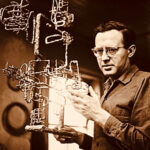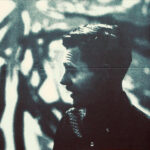Richard Diebenkorn
Richard Diebenkorn (1922-1993) stands as one of the most celebrated American painters of the 20th century, known for his unique contributions to both Abstract Expressionism and the later development of a more structured, lyrical abstraction. His career spanned several decades, and his evolving style reflects a deep engagement with color, form, and space. This biography explores Diebenkorn’s life, artistic development, and two of his most important artworks, illustrating his significant impact on modern art.

Early Life and Education
Richard Clifford Diebenkorn Jr. was born on April 22, 1922, in Portland, Oregon. The family moved to San Francisco when he was two years old, and it was in California that Diebenkorn grew up. His early interest in art was encouraged by his mother and grandmother, who provided him with art supplies and encouraged his drawing.
Diebenkorn began his formal art education at Stanford University in 1940, where he studied under Victor Arnautoff and Daniel Mendelowitz, who introduced him to the work of modern European artists such as Henri Matisse and Pablo Picasso. His education was interrupted by World War II, during which he served in the U.S. Marine Corps. After the war, he continued his studies at the California School of Fine Arts (CSFA) in San Francisco, where he was exposed to the burgeoning Abstract Expressionist movement.
Artistic Development and Early Career
At CSFA, Diebenkorn studied under influential artists such as Mark Rothko, Clyfford Still, and David Park. This period was crucial in shaping his early style, which was heavily influenced by Abstract Expressionism. Diebenkorn’s early works from the late 1940s and early 1950s are characterized by their gestural brushwork, bold use of color, and dynamic compositions, reflecting the influence of his teachers and the broader art movement.
In 1947, Diebenkorn had his first solo exhibition at the California Palace of the Legion of Honor in San Francisco. His work quickly gained recognition, and he became associated with the Bay Area Figurative Movement, a group of artists who sought to reintroduce figuration into abstract painting. This period marked a significant transition in Diebenkorn’s style as he began to experiment with figurative elements while maintaining an abstract sensibility.
Move to Southern California and Mature Style
In 1966, Diebenkorn moved to Southern California, where he took a teaching position at the University of California, Los Angeles (UCLA). This move marked a significant turning point in his career, as he began to develop the distinctive style for which he is best known. Influenced by the bright light and expansive landscapes of Southern California, Diebenkorn’s work became more structured and lyrical, characterized by an interplay of geometric forms and vibrant color fields.
The “Ocean Park” series, begun in 1967, represents the culmination of Diebenkorn’s mature style. Named after the neighborhood in Santa Monica where he had his studio, the series consists of over 140 paintings and numerous works on paper. These works are distinguished by their abstract compositions, which evoke the landscape and architecture of the area through a delicate balance of color, line, and form.
Important Artworks
“Ocean Park No. 54” (1972)
“Ocean Park No. 54” is one of the most celebrated works from Diebenkorn’s “Ocean Park” series. This large-scale painting exemplifies his mature style, characterized by its luminous color palette, geometric composition, and meticulous attention to detail. The work features an intricate arrangement of rectangles, lines, and planes, rendered in a harmonious blend of blues, greens, and ochres.
The painting’s composition suggests a window or a grid, inviting viewers to contemplate the interplay of light and space. The delicate layering of color and the subtle variations in tone create a sense of depth and movement, evoking the shifting light and atmospheric conditions of the coastal environment. “Ocean Park No. 54” is a testament to Diebenkorn’s mastery of color and form, demonstrating his ability to create compositions that are both structured and dynamic.
“Berkeley No. 3” (1953)
“Berkeley No. 3” is an important work from Diebenkorn’s earlier period, reflecting his engagement with Abstract Expressionism and his transition towards a more structured abstraction. Created during his time in Berkeley, California, this painting features bold, gestural brushstrokes and a vibrant color palette of reds, blues, and yellows.
The composition is dynamic and energetic, with overlapping planes and intersecting lines creating a sense of movement and tension. “Berkeley No. 3” captures the spontaneity and emotional intensity characteristic of Abstract Expressionism while also hinting at Diebenkorn’s later interest in more structured, geometric compositions. This work exemplifies his ability to balance abstraction and representation, making it a key piece in understanding his artistic development.
Later Career and Recognition
Throughout the 1970s and 1980s, Diebenkorn continued to develop and refine his distinctive style. His work was celebrated in numerous solo exhibitions, including a major retrospective at the Whitney Museum of American Art in 1976. This exhibition solidified his reputation as one of the leading figures in American art, showcasing the breadth and depth of his artistic achievements.
Diebenkorn’s influence extended beyond the United States, with exhibitions of his work held in Europe and Japan. His ability to blend abstraction with a sense of place and atmosphere resonated with audiences worldwide, earning him international acclaim. His work is included in the collections of major museums, including the Museum of Modern Art in New York, the San Francisco Museum of Modern Art, and the Tate Gallery in London.
Personal Life and Philosophy
Diebenkorn’s personal life was marked by his dedication to his art and his relationships with fellow artists. He maintained close friendships with many of his contemporaries, including David Park, Elmer Bischoff, and Wayne Thiebaud, whose ideas and techniques influenced his work. These relationships provided a supportive network that nurtured his creativity and inspired his work.
Diebenkorn viewed his paintings as a form of exploration and discovery, a way to engage with the world and convey his inner vision. He believed in the power of abstraction to evoke emotional and intellectual responses, and his work often reflects a deep sense of curiosity and wonder about the human experience. His philosophy of art emphasized the importance of balance and harmony, seeking to create compositions that were both visually striking and emotionally resonant.
Legacy and Influence
Richard Diebenkorn’s legacy as an artist lies in his ability to create a unique visual language that combines emotion, movement, and color. His innovative use of gestural abstraction and his dynamic compositions have left a lasting impact on the field of modern art, influencing generations of artists and viewers.
Diebenkorn’s works are included in the collections of major museums and galleries around the world, including the Museum of Modern Art in New York, the Whitney Museum of American Art, and the San Francisco Museum of Modern Art. His influence extends beyond his own paintings, as he also played a crucial role in advocating for the recognition and inclusion of abstract artists within the art world.
Conclusion
Richard Diebenkorn’s artistic journey is a testament to his creativity, resilience, and profound understanding of color and form. Through his innovative use of gestural abstraction and his dynamic compositions, he created a body of work that continues to inspire and challenge viewers. “Ocean Park No. 54” and “Berkeley No. 3” are just two examples of his ability to convey complex ideas and emotions through abstract forms and vibrant colors. Diebenkorn’s legacy as a master of abstract expressionism and a pioneer of modern art ensures that his work will continue to resonate with audiences for years to come.



